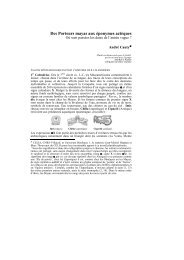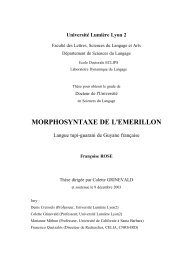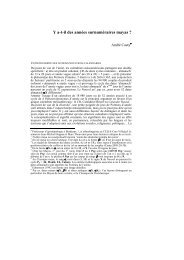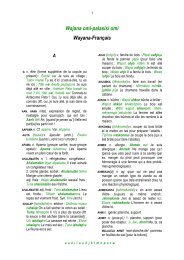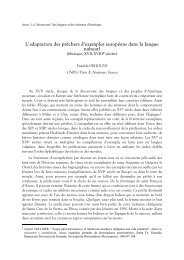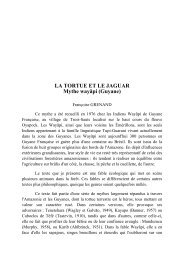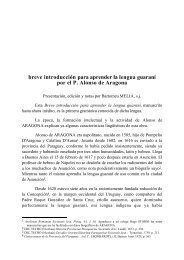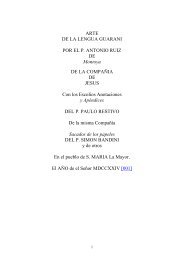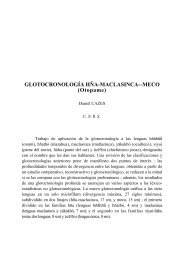The Blue Bird of Ergativity - celia
The Blue Bird of Ergativity - celia
The Blue Bird of Ergativity - celia
You also want an ePaper? Increase the reach of your titles
YUMPU automatically turns print PDFs into web optimized ePapers that Google loves.
"split ergative" pattern is probably better thought <strong>of</strong> as a variant <strong>of</strong> the inverse typethan <strong>of</strong> the ergative type (DeLancey 1981). (One aim <strong>of</strong> that paper was todemonstrate an underlying functional/cognitive unity to the superficially disparateaspect-based and person-based ergative "splits", but in retrospect I would say that,if the paper still has any value today, it is not that).Why we believe in ergativityWe have always, at some uncritical, pretheoretical level (and, most <strong>of</strong> thetime, in a very explicit theoretical sense), believed in the universality <strong>of</strong> Subject, inat least in Aristotelian sense. And for the most part we have not clearlydistinguished between that and believing in Subject and Object in the sense thatthey exist in Latin or English. We have always taken subject-formation, which wemay as well label "nominativity", to be the natural behavior <strong>of</strong> languages, so thatany language which does not immediately and obviously deviate from this patternis automatically considered to belong to it. <strong>The</strong>re are many languages which wouldstill be generally analyzed as "nominative" which in fact seem to be organized onquite different principles -- especially what Li and Thompson (1976) have called"topic-prominent" languages like Chinese, and, even more, certain peculiarvariations on that pattern such as Burmese. Chinese and similar languages have nosurface indication <strong>of</strong> case at all, and therefore no immediately evident reason toconsider them actively different from Latin or English; Burmese has distinctsubject- and object-marking postpositions, but uses them primarily to markdiscourse-pragmatically marked arguments (see e.g. Soe 1999).Thus, when we encountered languages which are immediately obviouslyorganized on different principles -- Basque, Georgian, Tibetan -- we had torecognize that there is another pattern, but, in good old-fashioned Europeandualistic thinking, that implies one other pattern, in opposition to the "natural"pattern that we are used to. As linguists slowly came to recognize the fundamentaldistinctness <strong>of</strong> the "active/stative" or "split-S" pattern <strong>of</strong> clause organization, wegrudgingly allowed for one more type, although, as we have noted, back in the1970's when these languages first started attracting the attention <strong>of</strong> typologists andtheoreticians, there was considerable debate here and there about whether theseshould be considered a distinct type, or some sort <strong>of</strong> weird subtype <strong>of</strong> ergativity,and even now the distinctness <strong>of</strong> "split-S" typology is not universally recognized.But this was as far as anyone wanted to go; when we had to deal with the likes <strong>of</strong>Hindi and Kiranti, rather than recognizing further new types, these were clearlyconsidered subtypes <strong>of</strong> ergative -- "split" ergative. Notice the presumption <strong>of</strong>5



